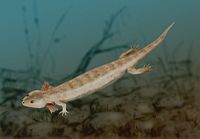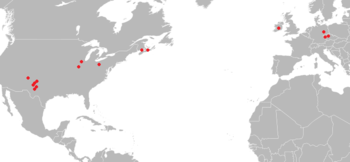- Microsauria
-
Microsauria
Temporal range: Late Carboniferous-Early Permian, 318.1–270.6 Ma
Possible descendant taxon Lissamphibia survives to present
Microsauria diversity. (Hyloplesion (A), Pantylus (B), Pelodosotis (C) & Rhynchonkos (D)) Scientific classification Kingdom: Animalia Phylum: Chordata Class: Amphibia Subclass: †Lepospondyli Order: Microsauria*
Dawson, 1863Suborders - Microbrachomorpha
- Tuditanomorpha
Microsauria ("small lizards") is an extinct order of lepospondyl amphibians from the late Carboniferous and early Permian periods. It is the most diverse and species-rich group of lepospondyls.[1][2] Recently, Microsauria has been considered paraphyletic, as several other non-microsaur lepospondyl groups such as Lysorophia seem to be nested in it.[1][3][4] Microsauria is now commonly used as a collective term for the grade of lepospondyls that were originally classified as members of Microsauria.[2]
The microsaurs all had short tails and small legs, but were otherwise quite varied in form. The group included lizard-like animals that were relatively well-adapted to living on dry land, burrowing forms, and others that, like the modern axolotl, retained their gills into adult life, and so presumably never left the water.[5]
They are possible ancestors of the newts and salamanders, if that group did not arise from the temnospondyls along with the frogs and toads.[5]
Contents
Distribution
Microsaur remains have been found from Europe and North America in Late Carboniferous and Early Permian localities. Most North American microsaurs have been found in the United States in Arizona,[6] Texas, Oklahoma, Ohio,[7] and Illinois, although remains have also been found in Nova Scotia.[8] In Europe, microsaurs are known from Germany and the Czech Republic. Possible microsaur remains have also been found from strata in the town of Vyazniki in the Vladimir Oblast of Russia.[9] These strata are Late Permian in age, near the Permo-Triassic boundary. The microsaur material at Vyazniki may be the youngest record of microsaurs, and would extend their range by around 20 million years.
Classification
Cladogram modified from Anderson (2001):[3]
Lepospondyli
MicrosaursHapsidopareiontidae Tuditanidae Ostodolepidae Pantylidae Gymnarthridae Brachystelechidae Scincosaurus
Urocordylidae Sauropleura
Urocordylus
Ptyonius
Keraterpetontidae Batrachiderpeton
Cladogram from Ruta and Coates (2007):[4]
"Microsauria" Odonterpeton
Hyloplesion
Microbrachis
Brachystelechidae
Tuditanidae
Hapsidopareiontidae
Ostodolepidae
Rhynchonkos
Gymnarthridae
Pantylidae
Lysorophia
Nectridea
Aïstopoda
References
- ^ a b Ruta, M.; Coates, M.I.; and Quicke, D.L.J. (2003). "Early tetrapod relationships revisited". Biological Reviews 78 (2): 251–345. doi:10.1017/S1464793102006103. PMID 12803423. http://pondside.uchicago.edu/oba/faculty/coates/5.RutCoaQuick2003.pdf.
- ^ a b Bolt, J.R.; and Rieppel, O. (2009). "The holotype skull of Llistrofus pricei Carroll and Gaskill, 1978 (Microsauria: Hapsidopareiontidae)". Journal of Paleontology 83 (3): 471–483. doi:10.1666/08-076.1. http://findarticles.com/p/articles/mi_qa3790/is_200905/ai_n32127776/.
- ^ a b Anderson, J.S. (2001). "The phylogenetic trunk: Maximal inclusion of taxa with missing data in an analysis of the Lepospondyli (Vertebrata, Tetrapoda)". Systematic Biology 50 (2): 170–193. doi:10.1080/10635150119889. PMID 12116927.
- ^ a b Ruta, M.; and Coates, M.I. (2007). "Dates, nodes, and character conflict: addressing the lissamphibian origin problem". Journal of Systematic Palaeontology 5: 69–122. doi:10.1017/S1477201906002008.
- ^ a b Palmer, D., ed (1999). The Marshall Illustrated Encyclopedia of Dinosaurs and Prehistoric Animals. London: Marshall Editions. p. 55. ISBN 1-84028-152-9.
- ^ Thayer, D.W. (1985). "New Pennsylvanian lepospondyl amphibians from the Swisshelm Mountains, Arizona". Journal of Paleontology 59 (3): 684–700.
- ^ Hook, R. W.; and Baird, D. (1986). "The Diamond Coal Mine of Linton, Ohio, and its Pennsylvanian-Age vertebrates". Journal of Vertebrate Paleontology 6 (2): 174–190. doi:10.1080/02724634.1986.10011609.
- ^ Steen, M.C. (1934). "The amphibian fauna from the South Joggins, Nova Scotia". Proceedings of the Zoological Society of London 104 (3): 465–504. doi:10.1111/j.1096-3642.1934.tb01644.x.
- ^ Sennikov, A.G.; and Golubev, V.K. (2006). "Vyazniki biotic assemblage of the terminal Permian". Paleontological Journal 40 (Suppl. 4): S475–S481. doi:10.1134/S0031030106100078. http://golubeff.narod.ru/PF/071_Golubev_2006_Biota_Permian_Russia.pdf.
External links
- Microsauria in the Paleobiology Database
Categories:- Prehistoric amphibians
- Carboniferous amphibians
- Permian amphibians
- Prehistoric amphibians of North America
- Prehistoric amphibians of Europe
- Prehistoric amphibian stubs
Wikimedia Foundation. 2010.


